Kristen McClarty has been working on a new series inspired by the lichen covered rocks near her home in Kommetjie. From plein-air paintings to woodblock prints, she has captured the landscape, the rocks and the sense of place of this unique corner of the world.
View her works for sale online here, or continue reading to find out a bit more about what drew her to the yellow rocks and her process of painting and creating a reduction woodblock print...
Kristen McClarty is a self-taught artist working out of her studio in Kommetjie. She grew up in Zululand in a creative maker home and started painting (and textile/stitched work) at a young age. Despite her love for art, she studied and practiced tax law for 14 years, working in large professional firms. She left the corporate world in 2009 to refocus on family and art, painting her surroundings in acrylic, plein air or from her photographs, combining painting with her own poetry. She started printmaking in early 2016 with Alma Vorster and since 2017 has worked independently, joining The Printing Girls in early 2020. Kristen's focus has been on relief and dry point intaglio, with a dabble in monotype and in January 2021, she moved to woodblock.
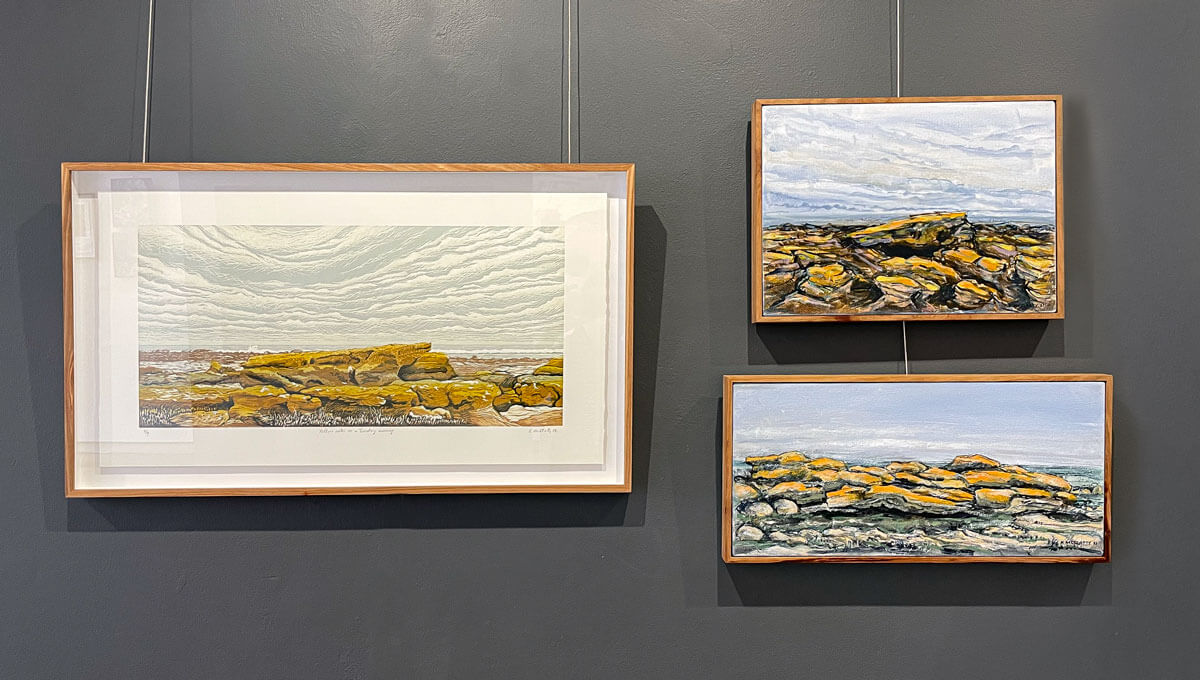
Hi Kristen, please tell us about your inspiration and how the idea for this new series of works depicting the lichen covered rocks came about?
There are some places that grab me and won’t let go. If I have ready access to that place, I can go there a hundred or a thousand times and each time I’ll be freshly taken aback by it. This place, that I loosely refer to as “Yellow Rocks” is where I walk most days and have done for almost 12 years. A stretch of coast that is exposed and windy and inhospitable, on an already harsh coastline. A place that pulls you and pushes you at the same time. I suppose its an obsession. One that has had me thinking for some time.
Mid 2021, I read the book “A Sense of Place” on the Scottish artist Joan Eardley. What struck me was her description of her painting practice… “I find the more I know of the place, or of one particular spot, the more I find to paint in that particular spot. I do feel the more you know of something, the more you can get out of it, the more it gives to you.” And so, some summers, Joan set up and painted the same vista every day, in every weather, each time allowing her attention to be drawn and swayed by different aspects.
This made me think more about my Yellow Rocks. It gave me the idea of tackling them in every way that I know how. I wanted to lay the rich yellow ochre paint on a canvas, and I also wanted to carve the shape in wood and print it. I wanted to stitch it onto a small cloth, making the shape with hundreds of short lines, coming together as one. So, I decided to do all these things, enjoying the place and the pull, feeling the edge of it, until it is enough.
This is called my Yellow Rocks series, and it has only just begun.
What draws you to this particular landscape and place?
My focus of the Yellow Rocks series is the harsh coastal stretch near Kommetjie, which is ancient but at the same time transient. Land that belongs to the sea; given a combination of spring tide, big swell and a long periods bringing rolling waves across the Atlantic, this land and the Yellow Rocks will be immersed. Dried kelp and accumulated shells, skeletons of seals already cleaned by scavengers and the elements, plants that survive on nothing but sand and salt, will all be washed over by the waves. Some of these things will be gone and some will remain, clinging to the rocks.
What draws me to it this area? It is just fascinating. Colour, shape, resilience, recovery, place of refuge, extreme exposure. The fact that this stretch of land has been like this for thousands of years. That the original residents here, while foraging along the coast for muscles and bird eggs, must have also felt a magnetism to this saturated yellow that contrasts the blue and grey of sea and sky.
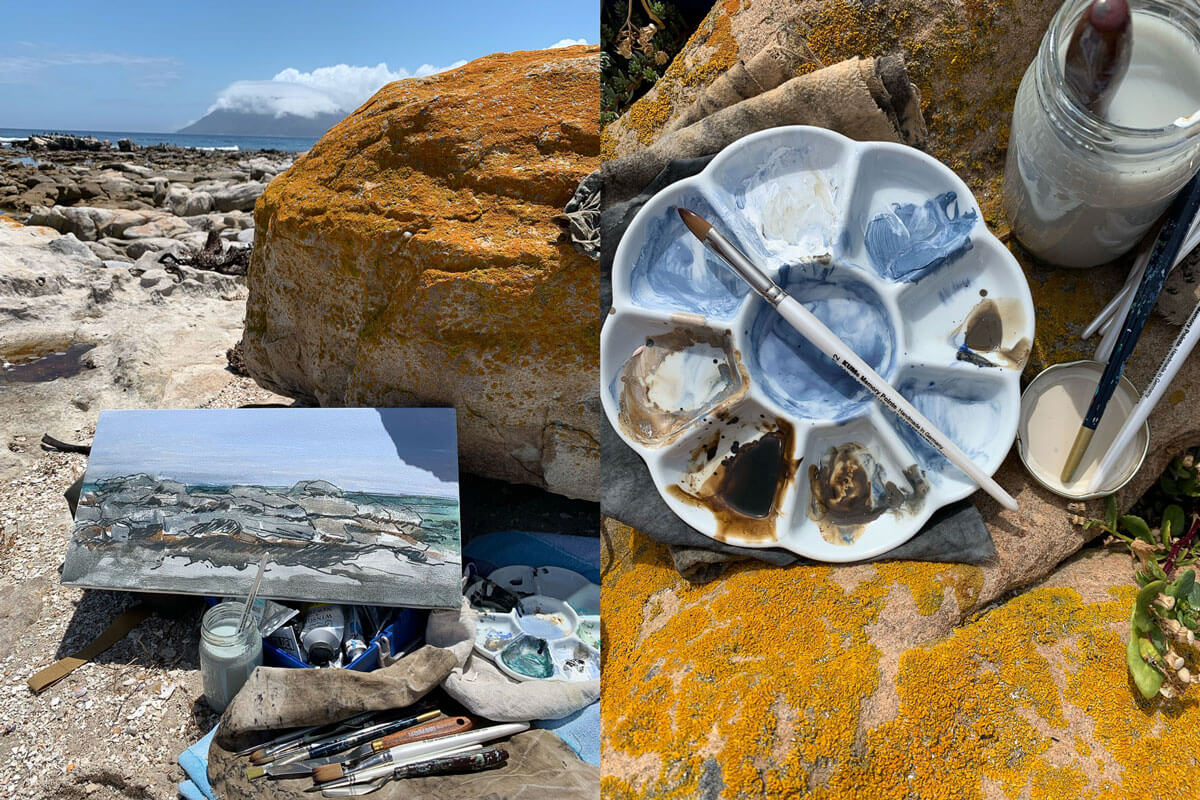
Can you tell us more about the yellow rocks and the location itself? (for example, why are they yellow?)
Along the stretch of coast from Scarborough to Kommetjie, where we live, a scattering of rocks is covered in lichen, which ranges in colour from a rich Naples yellow, to ochre, and through to a mustardy salmon. It is made up of a colony of the leafy lichen Xanthoria parietina, found on coastal rocks, walls, and trees, and sometimes called “yellow scale”. It is rich in a pigment called parietin and varies in colour depending on sun exposure and nutrients from bird droppings. I have noticed that when the rocks have been immersed by big seas, they are greenish until they are properly sun baked again.
This species of lichen has a wide distribution, but it cannot be in many places that it contrasts so vividly with the huge skies and the waves that pound the rocks or lick them in a lazy way, when the swell is small.
The Yellow Rocks are placed in my way so that my dog Axl and I have our morning walk, and after we’ve picked up a coffee, we circle back to the coast, invariably finding our way to an exposed spit of land called Bird Island. And hiding there, unseen by most, are the Yellow Rocks. I take photographs, videos, Axl patiently exploring. If the plovers are on eggs or have small chicks, they fake a broken wing, hobbling along. Axl stays on lead to avoid temptation. Amongst the crispy black dried kelp, hidden in a private burial, we find the skeleton of a seal. It is already clean. Like it has always been there. The Yellow Rocks are different every time. Seasons change the angle of the light, altering shadow and shade. Clouds pass overhead. We stand in a different place. The wind is whipping, or it is quiet. Salt spray. We are here on the edge of a coastal village, but we could be on a deserted island. Ancient, transient, accessible but untamed.
They are there and I want to share my connection with them, and so I do.
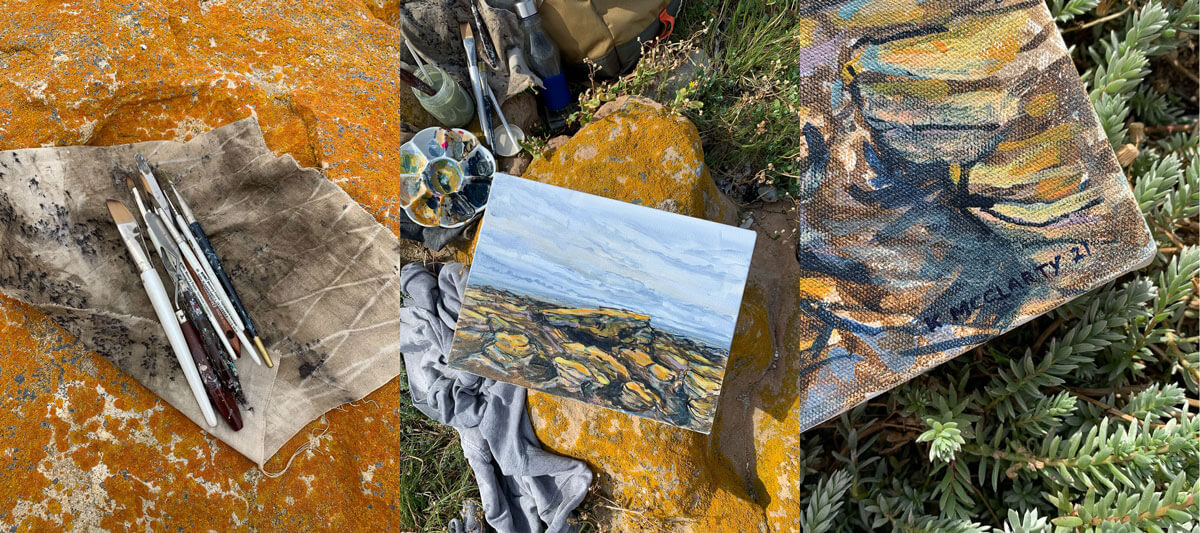
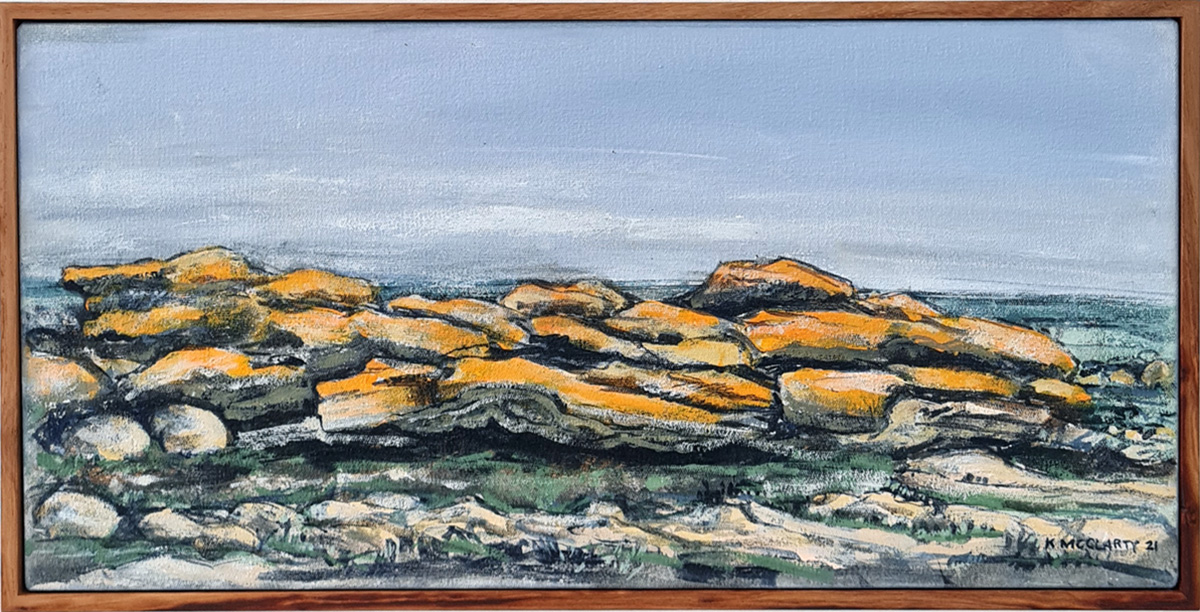
'Yellow Rocks II' by Kristen McClarty. Acrylic on canvas painting , 53 x 27cm.
You have captured the rocks in 2 different ways: firstly, painting en plein air with acrylic on canvas and then completing an 8-layer woodblock print. How did this process progress and what do you think each medium conveys best about the subject?
When I painted the Yellow Rocks, late in 2021, it was a return from a painting lacuna of 7 years or so. I had done plenty of painting, including plein air, for many years, but set this aside for some time, while I concentrated on developing my printmaking skills. Earlier last year, I started again with small water colour sketches, that found their way into woodblock prints. Reduction woodblock printmaking is a technical process that requires precision and concentration and needs to be undertaken with a certain strength and resilience. So, late last year, when all I wanted was to get those Yellow Rocks onto a surface, I hauled out my canvas and paints, and waited for a cloudy day to paint. So immediate and gratifying. And then I did it again. Bliss.
In a way, the plein air paintings were done in preparation for the reduction woodblock prints that followed, to better understand the shapes, shadows and most of all, the depth and richness of the yellow ochre; a colour that cannot be trifled with. But my thorough enjoyment of the immediate result of the painting process, means that I have brushed off tools and I will be painting again. At the same time, I am busy with a second large reduction woodblock print, using a different approach. And there will be more.
The process of making a reduction woodblock print has no short cuts. For me, it’s a slow and intuitive process of building up tone and texture, until the piece is complete. My colour is mixed and developed along with the piece. When carving, I am concentrating on the surface that remains, its edges and interaction with what has already been printed. By following the process to completion, I feel as though I am humbling myself to a place that that deserves to be seen. Celebrating it. Being in it and sharing how that feels. Accentuating what is already so powerful, so that it cannot be unseen.
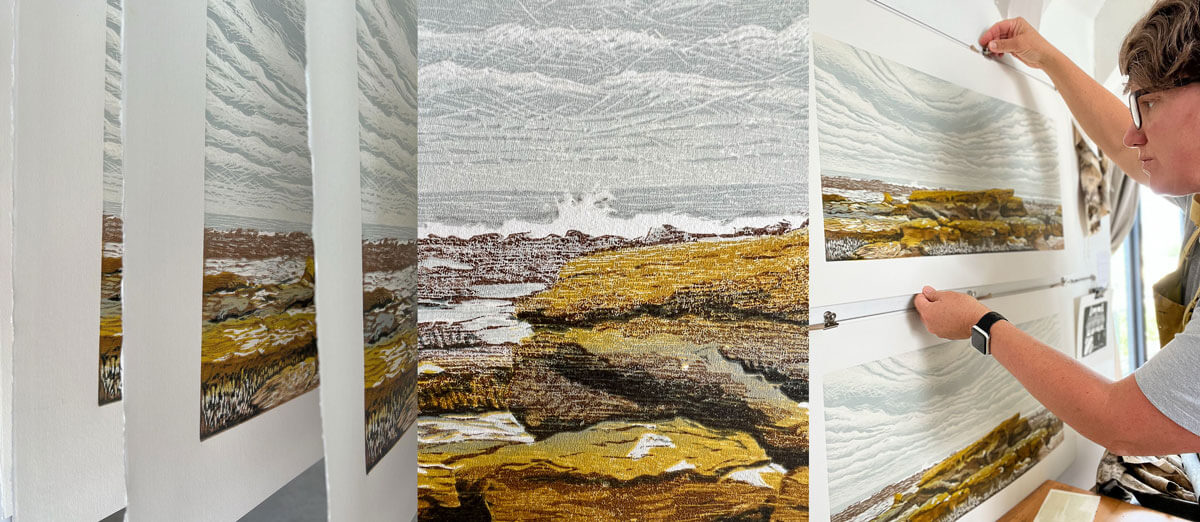
Do you have plans to take this series further? Are there any other mediums you would like to explore and what story would you like to tell?
The Yellow Rocks series will most likely be ongoing, given my a permanent relationship with them, living where I do. I have already made a small, stitched message cloth, including the rocks, but also referencing the local dirty graffiti that I love. This message cloth will be exhibited later this year in a group exhibition. There will certainly be more paintings and woodblock prints, in the Western and Japanese Mokuhanga style.
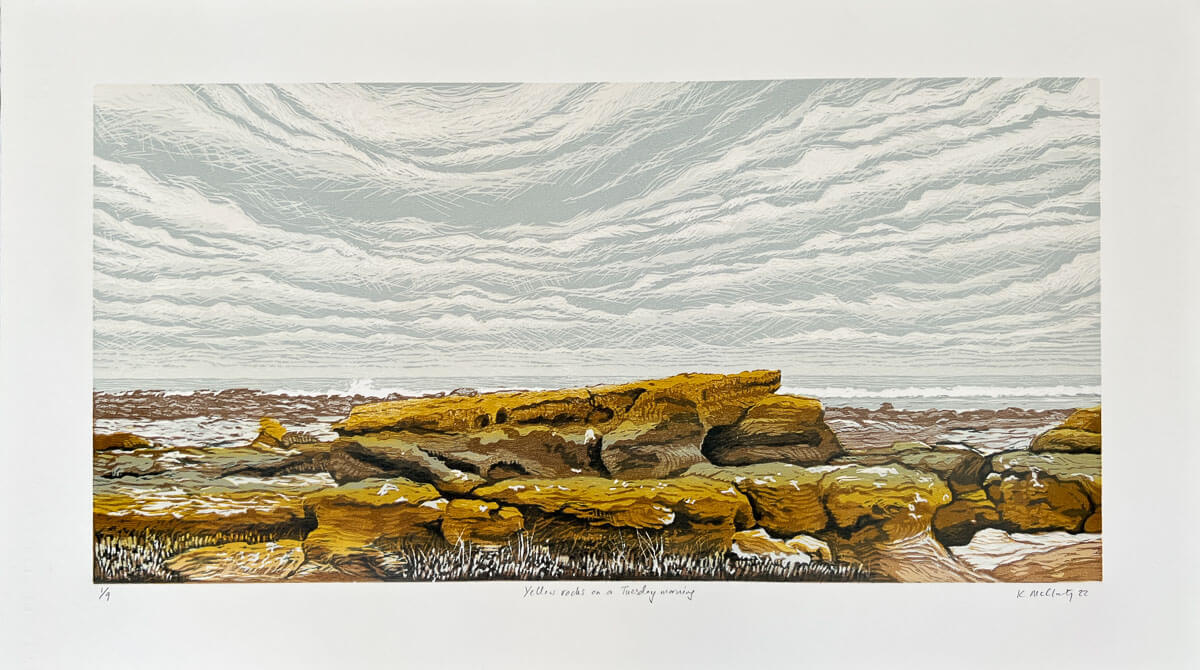
'Yellow Rocks on a Tuesday Morning' ed.2/9 by Kristen McClarty. Reduction woodblock print, 8 layers, 10 colours, 78.5 x 48cm framed.
Watch a short video of Kristen's process:
View these and more artworks by Kristen available for sale>>>

